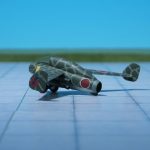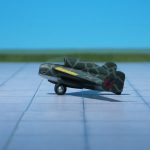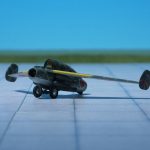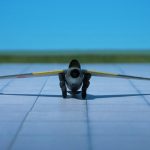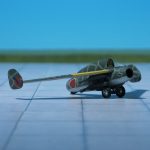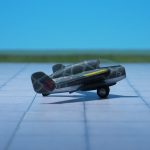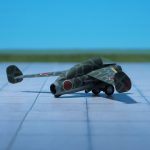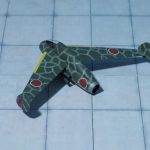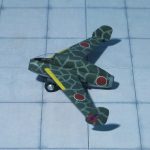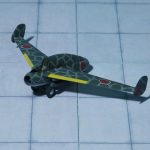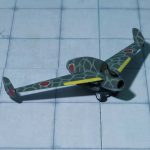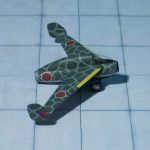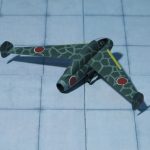TYPE: Interceptor. Project
ACCOMMODATION: Pilot only
POWER PLANT: One Kayaba Model 1 ramjet engine rated at 750 kp thrust at 457 mph and four solid fuel rocket boosters for take-off, rated at 7.200 kp thrust
PERFORMANCE: 559 mph (estimated)
COMMENT: The Kayaba “Katsuodori” (“Booby Gannet”) was the result of the endeavor to design a single-seat, ramjet-powered interceptor-minded platform which utilized a short, tailless fuselage configuration with swept-back wing main planes. The cockpit would be held well-forward and offered exceptional vision for the pilot. The mid-mounted main planes were affixed ahead of midship with each tip capped by small vertical stabilizers. The ramjet propulsion system was buried within the tubular fuselage and a rocket-assist scheme (consisting of four externally-held rocket pods) was to be used. The rocket pods were installed under the wing roots and jettisoned once their usefulness had run out. Having achieved the required speeds, the aircraft would then continue on under ramjet power with a flying window of about 30 minutes being estimated. To aspirate the ramjet, the nose section featured an air intake. No conventional undercarriage was provided. Instead the aircraft would glide back home powerless and land on a belly-mounted skid. The ramjet under consideration for the project became the Kayaba Model 1 which promised 750 kp thrust output.
Since the aircraft never achieved prototype form, performance specifications were estimated and this included a maximum speed of 560 miles per hour with a rate-of-climb around 11,000 feet-per-minute. The latter would prove a good quality to have in interception sorties. The service ceiling was listed at 49,215 feet
As an interceptor attempting to tackle very large, slow-moving (but well-defended) targets, it was seen to arm the fighter appropriately through 2 x 30mm Ho-301 series cannons – this was a suitable arrangement to counter even the high-flying and technologically advanced Boeing B-29 “Superfortress” which had made its presence known since mid-1944. The cannons would have been embedded in the sides of the nose.
Design work on the “Katsuodori” progressed into 1943 and plans were underway to begin construction of a working prototype for the following year. However, Japan’s fortunes in the war had worsened into 1944 and the attention of authorities turned to more viable military weapons such as the Rikugun (Mitsubishi) Ki-202 “Sharp Sword”, based on a rocket-powered interceptor developed by Mitsubishi as Ki-200 “Shusui” for the IJAAF and J8M-1 for the IJNAF on the basis of the German Messerschmitt Me 163 “Komet” (Ref.: 24).

